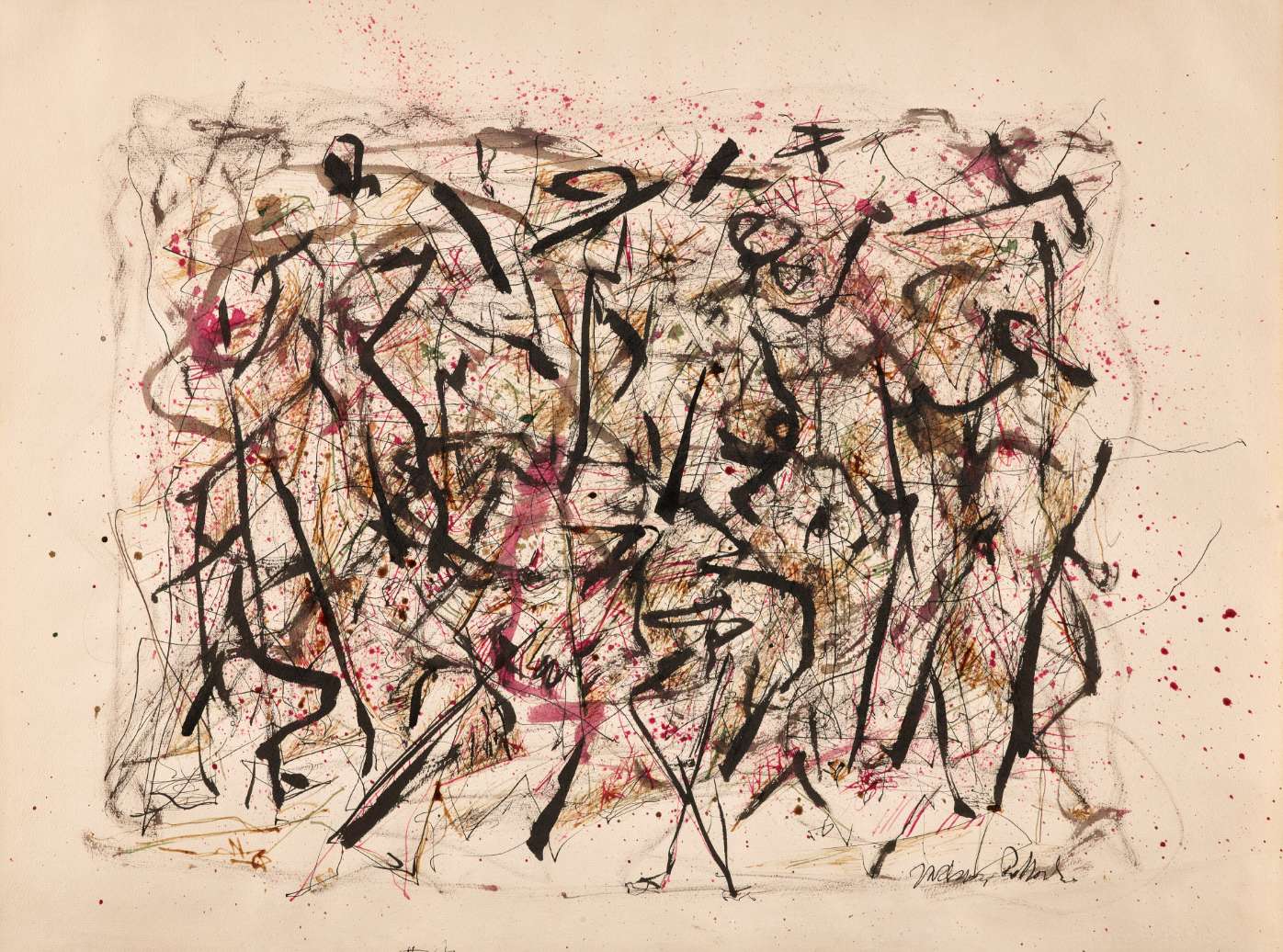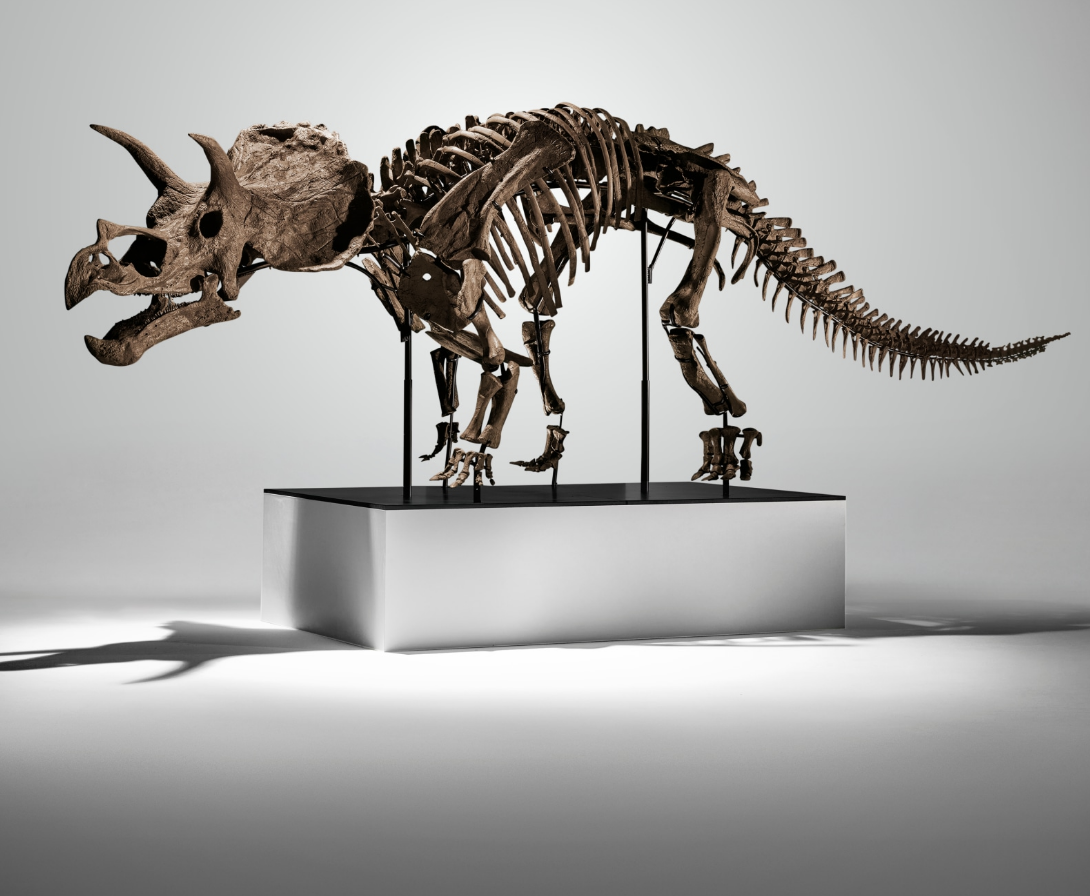Links:
Estimate: $2,800,000 - 3,500,000
CERA - Juvenile Triceratops Skeleton
Estimate: $2,500,000 - 3,500,000
This market resolves to the artwork which sells for a higher value at their upcoming Phillips auction.
Resolution details
Example from a past auction: this Patek Philippe watch lists "SOLD FOR CHF304,800". This is the equivalent number I will use.
Note that the final listed sale price typically includes the buyer's premium (and potentially other fees).
Edge cases:
If one is pulled before it is put up for auction, resolves N/A.
If one goes up for auction but fails to sell for any reason, it resolves to the other.
If there's a tie or they both fail to sell, both resolve at 50%.
Jackson Pollock - Untitled

Exploding with linear vitality, Untitled captures the pivotal moment when Jackson Pollock fused drawing, painting, and action into a single, radical language. Executed circa 1947, the work is among the earliest on paper to prelude the “drip” paintings that, as Willem de Kooning remarked, “broke the ice” for American painting and transformed the course of twentieth-century art. Echoing the radical technique of pouring, dripping, and flinging paint that Pollock developed in these years, the intricate layering of flicks, stains, and splatters demonstrates his ability to harness physical movement into a masterly balance of chaos and control. Each gesture preserves the immediacy of his action while coalescing into a delicate web of rhythmic energy, engaging the viewer with its spatial complexity and compositional sensitivity. (Lot essay)
CERA - Juvenile Triceratops Skeleton

Cera, a beautifully preserved juvenile Triceratops, is a singular example of this rarity. Measuring approximately 4.40 m in length and retaining over 70% original bone, the skeleton offers an intimate view of this iconic genus during an early stage of development. Its preservation, anatomical integrity and museum-quality mounting place it among the most significant juvenile dinosaur specimens ever offered and likely the finest juvenile Triceratops yet discovered. (Lot essay)
@Eliza it's a good question—i picked two items from the same auction, precisely because i would expect that makes it much more likely that fees are equivalent. but i wouldn't be 100% confident in that. (i.e., i think the buyer's premium formula is likely the same, but i'm not confident there couldn't be some other asymmetric fees)
@Eliza according to phillips' "conditions of sale", there is a standard-ish procedure here:
(a) Collection & Shipping if you are a Buyer of a Lot:
(i) Immediately following the Auction, all Lots (other than watch purchases) will be
transferred to Phillips’ shipping and art storage agent, SRI Fine Art Services (“SRI”)...
(ii) Free storage will be provided to you for a period of thirty (30) calendar days
following the Auction. If you have not collected your purchases by that date, you will
be charged fees and interest until they have been physically collected. Please see
section 8 below for further details for Uncollected Lots
it goes on for a while, but it sounds like you have ~30d to pick up the piece (although it's certainly possible that individual pieces don't the general rules). high level, i am fairly confident that whoever buys the triceratops needs to handle its (1) transport & (2) long term storage, & both are quite logistically difficult.
IIUC, it's pretty common to loan out dinosaur skeletons to museums, & the museum is probably already well equipped to handle transport & storage logistics. if you plan to loan it to a museum long term, i have no clue whether in practice that means you don't need your own separate storage plan. (& certainly if you want to display it in your own house, that's difficult)
@ItsMe this piece also strikes me as unfinished by Pollock's standards since the canvas edge is left exposed. not to mention it's tiny for a Pollock. That makes it more portable and easily stored for collectors, but less impressive for display
@ItsMe i am not a particular fan of pollock, so i can't too-earnestly sell you on this one, but a few high level points.
1) the value of an artwork is in part based on its culture/context/history, not purely its aesthetic merit when it sits in your living room today. this is the same for any other collectible object, and there's no reason to hold art to a different standard. i don't think people find it that confusing when newton's principia sells for a lot of money, purely due to its historical significance. nor is it that odd that people might want to see it in a museum. for this to apply, it requires jackson pollock to hold some historical significance. but generally i think people find it much easier to understand "maybe this painting technique was influential/innovative/important at the time" compared to "i should appreciate its aesthetic merits divorced from all context". if you don't understand how artists could possibly have found pollock to be influential/innovative at the time, i mention a few points in (2) but i don't think it'd be hard to look up some examples.
in other words, "a kid could have painted that!" if it were true (to be clear, it absolutely is not, see (2)), is not sufficient to imply that an artwork is not worth millions and/or not worth seeing in a museum. context matters.
2) in general, i would be wary of being too certain in the aesthetic merit of any physical artwork without seeing it in person. i put this second because i am sure you have seen pollocks in person before and still feel this way, so i don't think it's the primary issue here. but i do see commonly see people act like a pollock painting is equivalent to a kid throwing paint on the page, and to be blunt i have no clue wtf they are talking about, and it makes me wonder if they glanced at it and moved on. the paintings are wonderfully 3-dimensional, the textures he achieves are quite unusual/interesting (absolutely "for the time"—if the technique is so easy/obvious, it's odd that others didn't think to do them first—but also compared to what you find today. i have seen so many bad splatter paint artworks by amateurs!). whether or not you think the objective is worthwhile or a waste of time, there's a great deal of intent/care behind his style/technique.
fwiw, i do agree with pat that the size of this particular piece makes me dubious that i'd care for it in person. like with a rothko, i have never once found a picture of a pollock painting the slightest bit interesting, but occasionally when standing in front of a giant piece i've found myself quite absorbed.